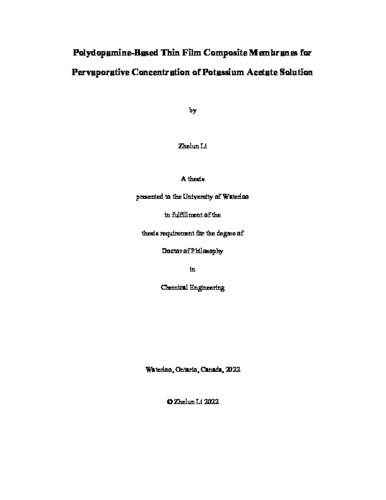UWSpace will be migrating to a new version of its software from July 29th to August 1st. UWSpace will be offline for all UW community members during this time.
Polydopamine-Based Thin Film Composite Membranes for Pervaporative Concentration of Potassium Acetate Solution
| dc.contributor.author | Li, Zhelun | |
| dc.date.accessioned | 2022-12-19 19:23:18 (GMT) | |
| dc.date.available | 2023-12-20 05:50:05 (GMT) | |
| dc.date.issued | 2022-12-19 | |
| dc.date.submitted | 2022-12-10 | |
| dc.identifier.uri | http://hdl.handle.net/10012/18958 | |
| dc.description.abstract | Potassium acetate (KAc) is a valuable chemical product due to its widespread application in multiple fields. During the production of KAc, the concentration of dilute KAc solution is a vital pre-treatment procedure to produce KAc powder or liquid concentrate of KAc. Several techniques have been applied to concentrate salt solutions, including evaporation, freeze crystallization and reverse osmosis (RO). However, these techniques either have high energy costs, complicated systems, or high operating pressures. Meanwhile, pervaporation is emerging as a promising technique for concentration of salt concentration, ascribing to its low energy consumption, mild working environment, and capacity to handle highly concentrated feeds. Attempts were thus made in this work to fabricate thin film composite (TFC) membranes favorable for the pervaporative concentration of KAc solutions. Among several technologies for manufacturing TFC membrane selective layer, self-polymerization of dopamine has become a promising technology for pervaporation concentration due to the ease of operation, diversity of target surface, and hydrophilicity of dopamine. However, the shortcoming is that polydopamine (PDA) is vulnerable to harsh environments, predominantly alkaline environments, ascribing to the non-covalent bonds in its structure. Besides, the polymerization of dopamine is a slow process, and the non-polar aromatic ring in the dopamine structure also limits the hydrophilicity of the coating. Therefore, a key point in this work is modifying dopamine polymerization to make it more favorable to fabricate membranes for pervaporative concentration. In the first work, self-assembled polyethyleneimine/poly(acrylic acid) (PEI/PAA) bilayers were applied as “tape” to deposit onto the PDA coating to make a dense and stable selective layer. It was shown that the number of polyelectrolyte bilayers could be effectively reduced by using a PDA sublayer in constructing the composite membranes. The TFC membrane with a single PEI/PAA bilayer on top of the PDA sublayer was adequate for the pervaporative concentration of the salts. The mass transfer resistance of the membranes was carried out via making membranes with different amounts of polyelectrolyte bilayers. However, the intrinsic property of the PDA coating was not modified in the first work, and the extra deposition process complicated the fabrication. In the second work, a single-step co-deposition of dopamine and polyvinylamine (PVAm) was carried out to take advantage of the covalent bonding between PDA and PVAm and the adhesive properties of PDA oligomers. It was shown that both the hydrophilicity and stability of the membrane were improved by incorporating PVAm into the membrane during the coating/deposition process. Moreover, the deposition was significantly accelerated. It was found that a PVAm content of 20-30 wt% (solvent free basis) in the PVAm/dopamine depositing solution was appropriate for fabricating TFC pervaporation membranes for concentrating aqueous KAc concentrations. Yet, the aforementioned fabrication processes were only conducted upon the hydrophilic surface. Applying this technique to hydrophobic surfaces, in fact, is more desired for the pervaporative concentration process from the water crossover point of view. However, the deposition of PVAm on hydrophobic surfaces is challenging because of its strong hydrophilicity nature. In the third work, the co-deposition of PVAm/dopamine was successfully applied to the hydrophobic polyvinylidene fluoride (PVDF) surface using methanol as a co-solvent with water and postponing the addition of PVAm. The investigations on how the methanol concentration and postponed time of adding PVAm affect the deposition kinetics were conducted. Moreover, the hollow fiber membranes were fabricated in this work which helps look into the perspective of this membrane in the actual industry. In the fourth project, the reactive oxygen species (ROS) co-produced by Cu2+/H2O2 was used alternatively as the oxidant to accelerate the co-deposition of PVAm/dopamine. A facile method was applied to lead the ROS generated around the target surface, enhancing the deposition kinetics and efficiency even further. Moreover, it was found that the facile method made the deposition solution reusable, and incorporating Cu2+ in the structure further improved the coating stability. All fabricated membranes were tested in a sweeping gas pervaporative concentration of KAc solution with a feed concentration up to 70 wt%. Comprehensive investigations on the permeate performance, including the water permeate flux, water permeance, and activation energy, were all carried out. | en |
| dc.language.iso | en | en |
| dc.publisher | University of Waterloo | en |
| dc.subject | membrane separation | en |
| dc.subject | pervaporation | en |
| dc.title | Polydopamine-Based Thin Film Composite Membranes for Pervaporative Concentration of Potassium Acetate Solution | en |
| dc.type | Doctoral Thesis | en |
| dc.pending | false | |
| uws-etd.degree.department | Chemical Engineering | en |
| uws-etd.degree.discipline | Chemical Engineering | en |
| uws-etd.degree.grantor | University of Waterloo | en |
| uws-etd.degree | Doctor of Philosophy | en |
| uws-etd.embargo.terms | 1 year | en |
| uws.contributor.advisor | Feng, Xianshe | |
| uws.contributor.affiliation1 | Faculty of Engineering | en |
| uws.published.city | Waterloo | en |
| uws.published.country | Canada | en |
| uws.published.province | Ontario | en |
| uws.typeOfResource | Text | en |
| uws.peerReviewStatus | Unreviewed | en |
| uws.scholarLevel | Graduate | en |

